Geometry, features, and orientation in vertebrate
animals: A pictorial review
Ken Cheng and Nora S. Newcombe
Macquarie University & Temple University
Pigeons
The results from pigeons resemble those from chicks (Kelly, Spetch, & Heth, 1998; Kelly & Spetch, 2001). Pigeons, however, were also tested on a vertically oriented computer monitor (below).
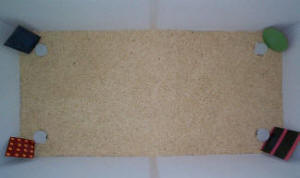 |
| Figure C-1: Kelly et al. apparatus. Thanks to Debbie Kelly for the pictures in this section. |
This picture shows an overhead view of an ‘open field’ arena used by Kelly et al. (1998). Panels in the corner served as featural cues, with the food always at one of the corners (reference memory task). The birds were disoriented between trials.
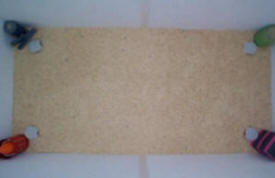 |
| Figure C-2: Kelly et al. apparatus with object cues |
Aside from two-dimensional panels, three-dimensional objects in the corners were also used as featural cues.
The Results were similar in the two cases. In the standard task, the birds were nearly perfect; they did not make systematic rotational errors. Thus, pigeons use features in the relocation task.
Systematic rotational errors did appear when the features were degraded in any of the manipulations that Kelly et al. tried
-
• Removing the colors of features by making them all the same color
-
• Removing the shapes of the features by making them all identical in shape
-
• Removing the feature at the target and the diagonal opposite
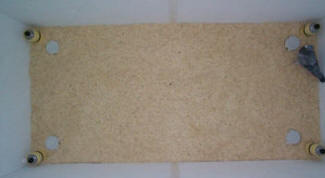 |
| Figure C-3: Kelly et al. apparatus with no featural cues |
Some birds were also tested with no features. This picture shows that identical landmarks in the corners make them nondiagnostic for locating the food.
Birds might be trained without features, or trained with features and then tested without features. In both cases, the pigeons used the geometric cues of the rectangle. They searched mostly at the correct corner or its diagonal opposite. Thus, as in chicks, having features during training did not overshadow the learning of geometry.
More on overshadowing in the section on cue competition.
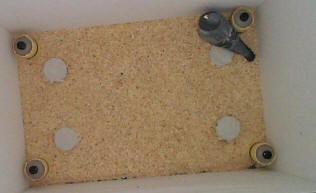 |
| Figure C4: Kelly &Spetch (2001) apparatus (small version) |
Pigeons were also tested with size transformations of the training arena (Kelly & Spetch, 2001). This picture shows a smaller test arena made by blocking off a part of the full arena. The long wall here is equal in absolute size to the short wall in the training arena.
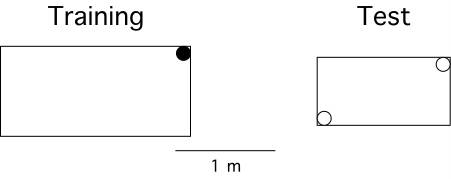 |
| Figure C-5: Kelly et al. size transformation experiment |
Pigeons responded according to the shape. In this example, they preferred to search at a corner with a shorter wall to the right and a longer wall to the left, even though in the test space, the absolute lengths of walls did not match those in the training space.
Pigeons have also been tested on a vertically oriented computer monitor (Kelly & Spetch, 2004b).
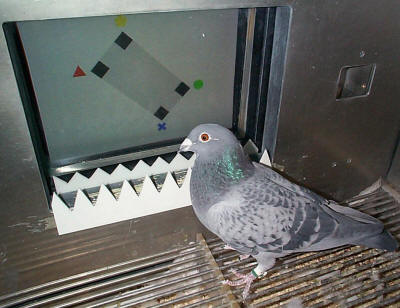 |
| Figure C-6: Stimulus and
subject in Kelly & Spetch's (2004b)
experiment. |
Here is a bird facing a schematic rectangle on the monitor of a computer. The task is much like the typical arena task; one corner of the schematic rectangle always leads to food when pecked. Pecks on the screen are picked up by a touchscreen device.
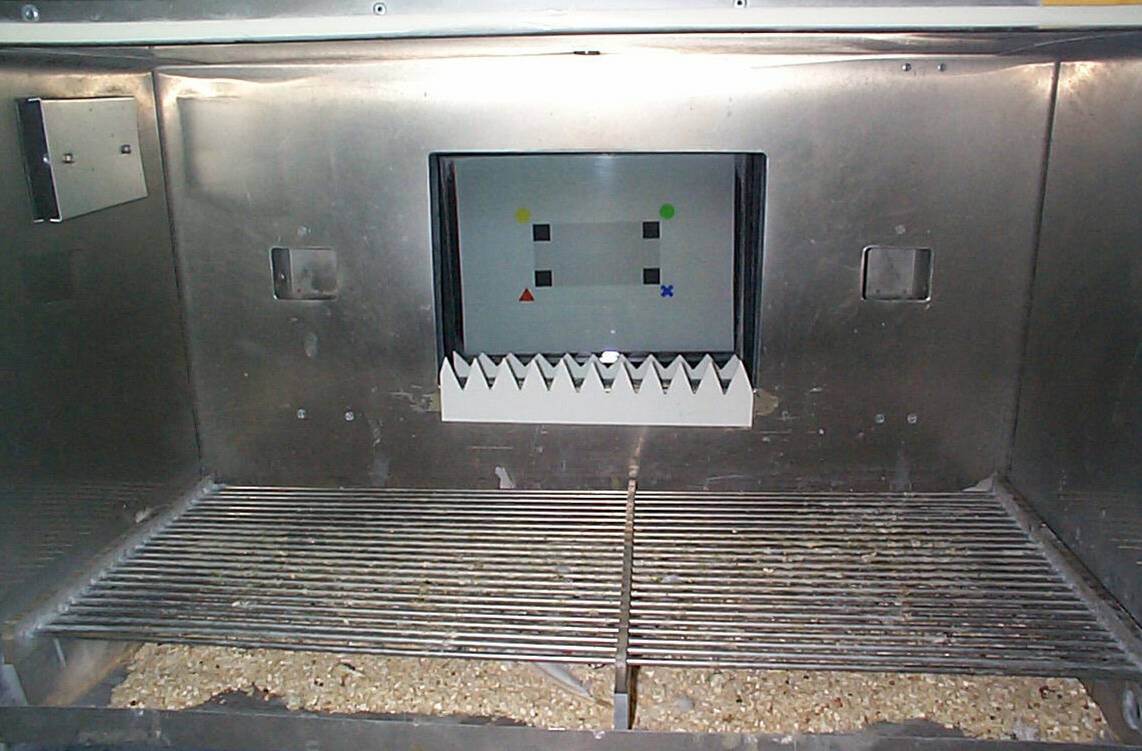 |
| Figure C-7: Stimulus in Kelly &
Spetch's (2004b) experiment. |
This is a view of the chamber in which the touchscreen monitor is found. Food for correct responses is delivered to one of the food magazines on each side of the monitor.
Note that the orientation of the rectangle can change from trial to trial, and that all stimuli are vertically presented. Both facts are important in accounting for the results. In training, six different orientations were used; two other orientations (180 degrees apart) were saved for transfer tests.
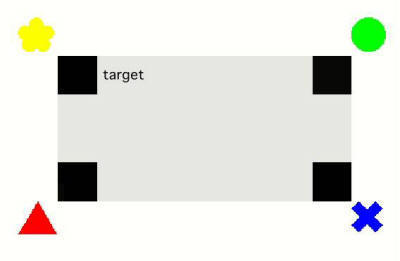 |
| Figure C-8: Stimulus properties in
Kelly & Spetch's (2004b) experiment. |
This is a schematic example of the training situation with both featural and geometric cues. Pigeons learned this task readily. They cope perfectly if the gray shading of the rectangle was removed on the test.
But other manipulations led to worse but still above chance performances:
-
• removing the color of features by making them all the same color
-
• removing the shape of features by making them all the same shape
-
• moving the configuration on the screen
-
• removing the features at the target and the diagonal opposite, as shown in the picture below
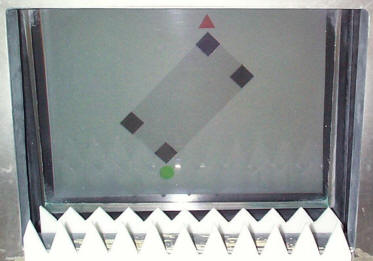 |
| Figure C-9:
A test with two of the features
removed.
|
|
||||||||||||||||||||
| Table C-1: Results from Kelly & Spetch's (2004b) experiment. |
Some manipulations led to the appearance of systematic rotational errors (Table C-1). When color information was removed by making all symbols the same color (shape only), when the feature at the target location and its diagonal opposite were removed (distant features), or when only a single feature at an adjacent corner was provided on a test (single feature), the percent of correct choices decreased compared with control tests. The errors, however, tended to be rotational errors. If the errors were distributed evenly, only one third of the errors should have been rotational errors, but the rotational errors in Table C-1 exceed this chance value.
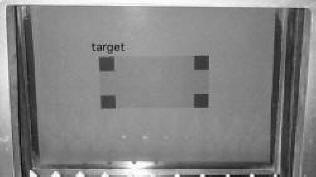 |
| Figure C-10: |
Pigeons were also trained and tested without featural cues; this tests whether they can learn to use geometric cues alone.
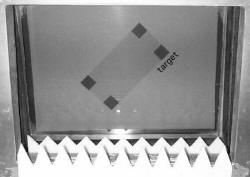 |
| Figure C-11: |
Again, six different orientations were used in training, with two new orientations (180 degrees apart) saved for transfer tests. The birds managed to learn geometry, but a few characteristics of the results are very interesting.
Interesting results with geometric cues only
-
•When started on this task, learning was slow, significantly slower than learning the featural task shown above.
-
• Having learned the featural task first sped the learning of this task. Features, far from overshadowing the learning of geometry, may have facilitated the learning of geometry.
-
• Pigeons did not transfer at all to the new orientations. This suggests that what they learned was orientation specific. A likely explanation is that on a vertical surface, the orientation with respect to gravity (i.e., up-down) defines a axis that is used for orientation.
-
• Again, removing the gray shading of the rectangle did not affect performance, while translating the rectangle led to a significant drop in performance that was, however, still above chance.
-
Kelly and Spetch’s (2004a) data on human adults on the touchscreen task showed many similarities.
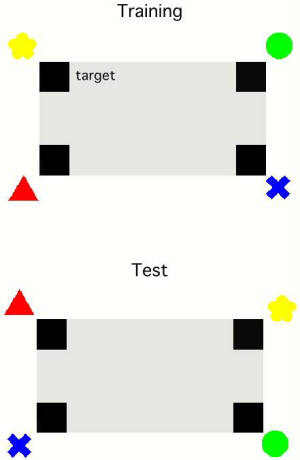 |
| Figure C-12: |
Featural and geometric cues are put in conflict in the test shown in the lower panel. At this stage, the birds had learned both the featural task and the geometric task. The birds’ choices indicate the use of both geometric and featural cues. Thus, in this example, they chose the red, green (geometrically correct) and yellow (featurally correct) cues more often than the blue cross (which is the only location that is both geometrically and featurally wrong).
|